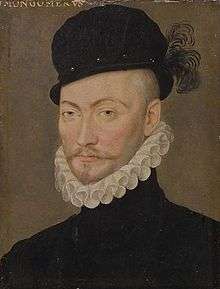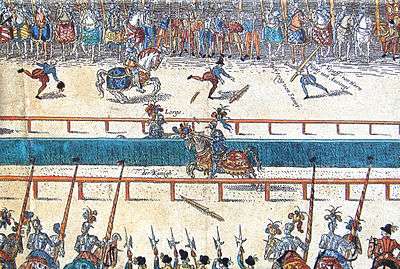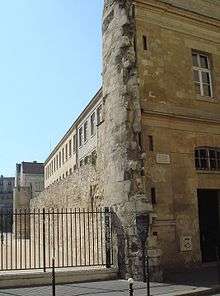Gabriel, comte de Montgomery
| Gabriel, comte de Montgomery, seigneur de Lorges | |
|---|---|
 Gabriel de Lorges comte de Montgomery (1530-1574), Kunsthistorisches Museum, Vienna | |
| Born | 5 May 1530 |
| Died | 26 June 1574 (aged 44) |
| Nationality | French |
| Citizenship | French |
Gabriel, comte de Montgomery, seigneur de Lorges (5 May 1530 – 26 June 1574), a French nobleman, was a captain of the Scots Guards of King Henry II of France. He is remembered for mortally injuring King Henry II in a jousting accident and subsequently converting to Protestantism, the faith that the Scots Guard sought to suppress. He became a leader of the Huguenots.
Career
On either 30 June or 1 July 1559, during a jousting match to celebrate the Peace of Cateau Cambrésis between Henry II and his longtime Habsburg enemies, a splinter of wood from Montgomery's shattered lance pierced Henry's eye and entered his brain, mortally injuring him. From his deathbed Henry absolved Montgomery of any blame, but, finding himself disgraced, Montgomery retreated to his estates in Normandy. There he studied theology and converted to Protestantism, making him an enemy of the state.


In 1562, Montgomery allied himself with another Protestant convert, Louis I de Bourbon, prince de Condé. He was one of the few refugees to survive the St. Bartholomew's Day massacre after a wounded Huguenot swam across the Seine to warn him that rioting had begun. He took control of Bourges and during September and October defended Rouen from the Royal Army. A price was put on his head, but he managed to escape to England. The queen mother, Catherine de' Medici, asked Queen Elizabeth I for his extradition, but Elizabeth refused.

Montgomery returned to France with a fleet in an attempt to relieve the Siege of La Rochelle in 1573. The following year he attempted an insurrection in Normandy, but was captured, taken to Paris,[1] and sentenced to death. On 26 June 1574, as he was about to be beheaded, Montgomery was informed that a royal edict had proclaimed that his property would be confiscated and his children deprived of their titles.
A freely adapted version of Montgomery's life is told in Alexandre Dumas' novel The Two Dianas.
Marriage and issue
He married Isabeau de La Touche (1550–1593), by whom he had four sons and four daughters:[2]
Sons
- Jacques 1 de Montgomery (1551–1560)
- Gédéon de Montgomery (died 1596)
- Gilles de Montgomery (1558–1596)
- Gabriel II de Montgomery (1565–1635), who built the Château de Ducey, and was father to six children:
- Louise de Montgomery
- Gabriel III de Montgomery (1560–1635)
- Suzanne de Montgomery
- Louis I de Montgomery (1601–1682)
- Jean de Montgomery (1605–1694)
- Jacques III de Montgomery (1609–1682).
Daughters
- Suzanne de Montgomery
- Elisabeth de Montgomery
- Claude de Montgomery
- Roberte de Montgomery, wife of Gawen Champernowne (d.1591) of Dartington in Devon, by whom she had issue. In 1582 she divorced him for adultery and in 1595 remarried to Thomas Horner of Cloford.[3]
Notes
- ↑

- ↑ Source:French Wikipedia
- ↑ Vivian, Lt.Col. J. L., (Ed.) The Visitations of the County of Devon: Comprising the Heralds' Visitations of 1531, 1564 & 1620, Exeter, 1895, p. 163, pedigree of Champernowne
References
- Landurant, Alain (1988). Montgommery le régicide. Paris: Tallandier. ISBN 2-235-01773-8.
- The Papacy and the Levant, (1204-1571).: The sixteenth century from Julius III to Pius V on Google Books
